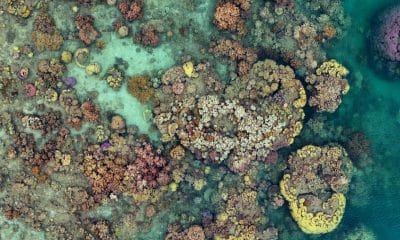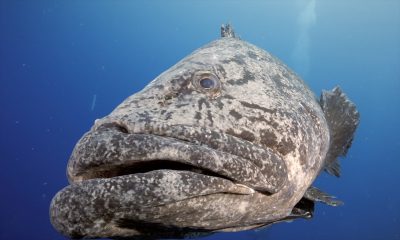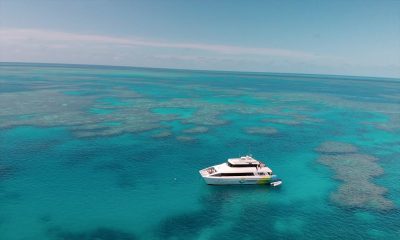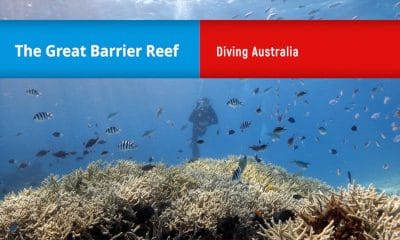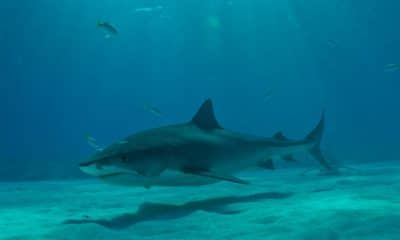News
Great Barrier Reef protection plan report card fails to make the grade

The Queensland government’s Reef Water Quality Protection Plan released its Report Card 2014 on September 21. It states, “Results show the need to accelerate the rate of change and drive innovation to meet the ambitious targets.”
Queensland Environment Minister Steven Miles, who released the report, said there was more bad news than good in the report.
“If one of my kids came home with a report card like this, I’d be a bit disappointed,” he said.
“What is most disturbing is these results are far from our targets, and progress to these targets flatlined in the period 2013-2014. The report does show that progress on meeting our targets had stalled, and that UNESCO’s interest was the right thing; that they were right to be concerned that progress had stalled, because now we know it had,” he said.
The reef report card found despite it avoiding an ‘in danger’ listing from Unesco’s world heritage committee in July, inshore areas are undeniably in a bad shape throughout the 2,300km-long ecosystem..
The report card said that both sea grass beds and inshore coral reefs “remained in poor condition overall”.
While there had been reductions in the amount of chemicals flowing onto the reef from agriculture, the report found only 13% of Queensland sugar cane producers had adopted ‘best management practice’ in terms of nutrients, with only 30% using best practice with pesticides. Only 28% of graziers were managing their pastures properly to protect the reef, the report found.
The report card said 330 hectares of reef wetlands and 30,980 hectares of riverbank vegetation was lost between 2009 and 2013.
“There are some trends that are improving but more needs to be done,” said Roger Shaw, chairperson of the scientific panel responsible for the report card.
“We know the pollutant levels exceed the guidelines so we need to bring them back down. The inshore area is still recovering from major floods we had in 2010 and 2011. Climate change is still the number one threat but I’d add climate variability too — if we have extreme events in a short period of time, there is less capacity for coral to deal with other stressors.”
“The figures in the reef report card represent a clear fail for current programs,” said WWF spokesperson Sean Hoobin.
“Governments have promised to give the reef the clean water it needs to recover by 2025 — to meet this commitment they will need to overhaul current programs, and provide significant additional resources.
“Key first steps are to enforce existing regulations to stop overuse of fertilisers. Leading farmers are showing that it is possible to achieve big reductions in fertiliser pollution while still being profitable.”
The Water Quality Protection Plan needs to be seen within the context of Reef 2050 Long-Term Sustainability Plan (which incorporates water quality).
In a formal response to the Reef 2050 plan in 2014, the Australian Academy of Science stated that the strategy is “inadequate to achieve the goal of restoring or even maintaining the diminished outstanding universal value of the reef”, noting there was “no adequate recognition” of the importance of curbing greenhouse gas emissions.
Professor Terry Hughes, director of the Australian Research Council Centre of Excellence for Coral Reef Studies and an academy fellow, said: “There’s nothing in the plan on addressing climate change. The science is quite clear that you can’t keep the Great Barrier Reef in good condition if you’re going to develop huge coal reserves. We are already on our way to 2°C warming and unless Australia cuts back on carbon dioxide emissions we won’t have much of a Great Barrier Reef left.”
The day after the release of report card 2014 the federal government announced in Cairns the $32 million research hub, which will be led by the Reef and Rainforest Research Centre and James Cook University researcher Dr Damien Burrows, to connect scientists, policymakers and communities to deliver a research program that provides practical solutions to maintaining and improving water quality.
One of the research projects highlighted was the development of a tradable permit scheme for cost-effective reduction of nitrogen run-off in sugarcane reef catchments. Market mechanisms are unlikely to lead to improved water quality. Enforcement of existing penalties against polluters are preferable responses.
The Australian Marine Conservation Society welcomed the federal government’s announcement of the Tropical Water Quality Hub in a September 22 media release, but warned of other dangers, including global warming and “unbridled industrialisation of the Reef”.
AMCS Great Barrier Reef campaigner Gemma Plesman said: “While the Reef Trust will help address water quality, other significant challenges remain.
“The unbridled industrialisation of the Reef presents further risks that will not be addressed with this announcement.
“More needs to be done, including rejecting the coal port proposal for Abbot Point which includes massive amounts of dredging that could put nesting turtles under even greater risk.
“Despite all of the evidence of risk to the Reef, the state and federal Governments are still pushing ahead with their plans for the Abbot Point coal port expansion.
“Water quality is only one piece of the puzzle. Abbot Point presents further risks to this natural wonder.
“The expansion would see 1.1 million cubic metres of the Great Barrier Reef World Heritage Area dredged and then dumped on land adjacent to the internationally significant Caley Valley Wetlands which support 40,000 birds in a good wet season.
“This project would also mean an extra 390 coal ships crossing the Reef each year, increasing the potential for devastating oil spills.
“The Abbot Point expansion would also enable a dramatic increase in the mining and burning of coal which contributes to global warming and places even greater pressure on this fragile ecosystem,” Plesman said.
Source: www.greenleft.org.au
Blogs
Northern Red Sea Reefs and Wrecks Trip Report, Part 2: Wall to Wall Wrecks

Jake Davies boards Ghazala Explorer for an unforgettable Red Sea diving experience…
The second day’s diving was a day full of wreck diving at Abu Nuhas, which included the Chrisoula K, Carnatic, and Ghiannis D. The first dive of the day was onto the Chrisoula K, also known as the wreck of tiles. The 98m vessel remains largely intact where she was loaded with tiles which can be seen throughout the hold. The stern sits at 26m and the bow just below the surface. One of the highlights of the wreck is heading inside and seeing the workroom where the machinery used for cutting the tiles are perfectly intact. The bow provided some relaxing scenery as the bright sunlight highlighted the colours of the soft coral reef and the many reef fish.

Following breakfast, we then headed to the next wreck, which was the Carnatic. The Carnatic is an 89.9m sail steamer vessel that was built in Britain back in 1862. She ran aground on the reef back in 1869 and remains at 27m. At the time, she was carrying a range of items, including 40,000 sterling in gold. An impressive wreck where much of the superstructure remains, and the two large masts lay on the seafloor. The wooden ribs of the hull provide structures for lots of soft corals, and into the stern section, the light beams through, bouncing off the large shoals of glass fish that can be found using the structure as shelter from the larger predators that are found outside of the wreck.

The final wreck at Abu Nuhas was the Ghiannis D, originally called ‘Shoyo Maru,’ which was 99.5m long and built in Japan back in 1969 before becoming a Greek-registered cargo ship in 1980. The ship then ran aground on the reef on April 19th, 1983, and now sits at the bottom at a depth of 27m. Heading down the line, the stern of the ship remains in good condition compared to the rest of the hull. The highlight of the wreck, though, is heading into the stern section and down the flights of stairs to enter the engine room, which remains in good condition and is definitely worth exploring. After exploring the interior section of the ship, we then headed over to see the rest of the superstructure, where it’s particularly interesting to see the large table corals that have grown at the bow relatively quickly considering the date the ship sank. After surfacing and enjoying some afternoon snacks, we made sure everything was strapped down and secured as we would be heading north and crossing the Gulf of Suez, where the winds were still creating plenty of chop.

The next morning, it was a short hop to Ras Mohammed Nature Reserve for the next couple of days of diving. The 6am wake-up call came along with the briefing for the first site we would be diving, which was Shark & Yolanda. The low current conditions allowed us to start the dive at Anemone City, where we would drift along the steep, coral-filled wall. These dives involved drifts, as mooring in Ras Mohammed wasn’t allowed to protect the reefs. As a dive site, Shark & Yolanda is well-known and historically had a lot of sharks, but unfortunately not so many in recent years, especially not so early in the season. However, there was always a chance when looking out into the blue.

The gentle drift took us along the steep walls of the site, with plenty of anemone fish to be seen and a huge variety of corals. It wasn’t long into the dive before we were accompanied by a hawksbill turtle, who drifted with us between the two atolls before parting ways. Between the two reefs, the shallow patch with parts of coral heads surrounded by sand provided the chance to see a few blue-spotted stingrays that were mainly resting underneath the corals and are always a pleasure to see. With this being the morning dive, the early sunlight lit up the walls, providing tranquil moments. Looking out into the blue, there was very little to be seen, but a small shoal of batfish shimmering underneath the sunlight was a moment to capture as we watched them swim by as they watched us.

Towards the end of the dive, we stopped at the wreck of the Jolanda where the seafloor was scattered with toilets from the containers it was carrying. This provided a unique site to make a safety stop, which was also accompanied by a large barracuda slowly swimming by, along with a hawksbill turtle calmly swimming over the reef as the sun rays danced in the distance.
For the next dive, we headed north to the Strait of Tiran to explore the reefs situated between Tiran Island and Sharm El Sheik, which were named after the British divers who had found them. We started on Jackson before heading to Gordons Reef, where we also did the night dive. All the atolls at these sites provided stunning, bustling coral reefs close to the surface and steep walls to swim along, which always provided the opportunity to keep an eye out for some of the larger species that can be seen in the blue. Midwater around Jackson Reef was filled with red-toothed triggerfish and shoals of banner fish, which at times were so dense that you couldn’t see into the blue. Moments went by peacefully as we enjoyed the slow drift above the reef, watching these shoals swim around under the mid-afternoon sun.

The night dive at Gordon’s Reef was mainly among the stacks of corals surrounded by sand, which was great to explore under the darkness. After some time circling the corals, we came across what we were really hoping to find, and that was an octopus hunting on the reef. We spent the majority of the dive just watching it crawl among the reef, blending into its changing surroundings through changes in colour and skin texture. It’s always so fascinating and captivating to watch these incredibly intelligent animals, in awe of their ability to carry out these physical changes to perfectly blend into the reef. Before we knew it, it was time to head back to the boat to enjoy a well-deserved tasty dinner prepared by the talented chefs onboard.
Check in for the 3rd and final part of this series from Jake tomorrow!
To find out more about the Northern Red Sea reef and wrecks itineraries aboard Ghazala Explorer, or to book, contact Scuba Travel now:
Email: dive@scubatravel.com
Tel: +44 (0)1483 411590
Photos: Jake Davies / Avalon.Red
Marine Life & Conservation
Double Bubble for Basking Sharks

 The Shark Trust is excited to announce that, for two more days only, all donations, large or small, will be doubled in the Big Give Green Match Fund!
The Shark Trust is excited to announce that, for two more days only, all donations, large or small, will be doubled in the Big Give Green Match Fund!
Donate to Basking in Nature: Sighting Giants
The Shark Trust is hoping to raise £10k which will be doubled to £20k. This will go towards Basking in Nature: Sighting Giants. And they need YOUR help to reach they’re goal.
The Shark Trust’s citizen science project is to monitor and assess basking sharks through sightings; encouraging data collection, community engagement, and promoting nature accessibility. This initiative aims to enhance health and wellbeing by fostering a deeper connection with British Sharks.
Campaign Aims
- Increase citizen science reporting of Basking Sharks and other shark sightings to help inform shark and ray conservation.
- Provide educational talks about the diverse range of sharks and rays in British waters and accessible identification guides!
- Create engaging and fun information panels on how to ID the amazing sharks and rays we have on our doorstep! These can be used on coastal paths around the Southwest. With activities and information on how you can make a difference for sharks and rays!
- Promote mental wellbeing through increasing time in nature and discovering the wonders beneath the waves!
Donate, and double your impact. Click Here
-

 News3 months ago
News3 months agoHone your underwater photography skills with Alphamarine Photography at Red Sea Diving Safari in March
-

 News3 months ago
News3 months agoCapturing Critters in Lembeh Underwater Photography Workshop 2024: Event Roundup
-

 Marine Life & Conservation Blogs2 months ago
Marine Life & Conservation Blogs2 months agoCreature Feature: Swell Sharks
-

 Blogs2 months ago
Blogs2 months agoMurex Resorts: Passport to Paradise!
-

 Blogs2 months ago
Blogs2 months agoDiver Discovering Whale Skeletons Beneath Ice Judged World’s Best Underwater Photograph
-

 Gear Reviews2 months ago
Gear Reviews2 months agoGear Review: Oceanic+ Dive Housing for iPhone
-

 Marine Life & Conservation2 months ago
Marine Life & Conservation2 months agoSave the Manatee Club launches brand new webcams at Silver Springs State Park, Florida
-

 News3 months ago
News3 months agoWorld’s Best Underwater Photographers Unveil Breathtaking Images at World Shootout 2023





